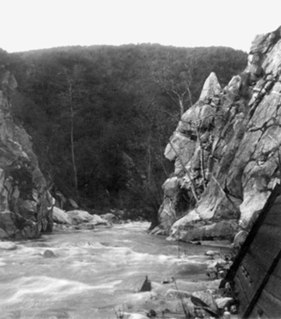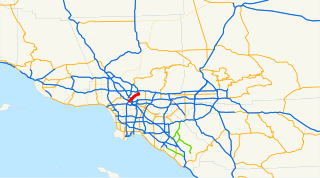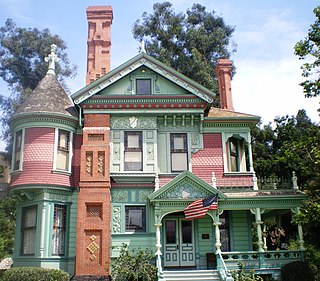 W
WThe Arroyo Seco, meaning "dry stream" in Spanish, is a 24.9-mile-long (40.1 km) seasonal river, canyon, watershed, and cultural area in Los Angeles County, California. The area was explored by Gaspar de Portolà who named the stream Arroyo Seco as this canyon had the least water of any they had seen. During this exploration he met the Chief Hahamog-na (Hahamonga) of the Tongva Indians.
 W
WThe Arroyo Seco Bicycle Path is an approximately 2 miles (3.2 km) long Class I bicycle path along the Arroyo Seco river channel in the Northeast Los Angeles region of Los Angeles County, California. It parallels to the Arroyo Seco Parkway also in the canyon.
 W
WThe Arroyo Seco Parkway, also known as the Pasadena Freeway, is the first freeway built in the United States. It connects Los Angeles with Pasadena alongside the Arroyo Seco seasonal river. It is notable not only for being the first, mostly opened in 1940, but for representing the transitional phase between early parkways and modern freeways. It conformed to modern standards when it was built, but is now regarded as a narrow, outdated roadway. A 1953 extension brought the south end to the Four Level Interchange in downtown Los Angeles and a connection with the rest of the freeway system.
 W
WThe Batchelder House is a historic home built in 1910 and located at 626 South Arroyo Boulevard in Pasadena, California. An important center of Pasadena cultural life in its day, the home was designed and built by Ernest A. Batchelder, a prominent leader of the Arts and Crafts Movement, and his wife, Alice Coleman, an accomplished musician. The house, a large bungalow, has a "woodsy" design with elements of a Swiss chalet style. Batchelder's first craft shop was located in the structure, where decorative tiles were made for Greene and Greene, the Heineman Brothers, and other noted local architects of the era. Coleman also used the house's backyard stage to host chamber music concerts.
 W
WErnest Allan Batchelder was an American artist and educator who made Southern California his home in the early 20th century. He created art tiles and was a leader in the American Arts and Crafts Movement.
 W
WBrookside Golf Course is a municipal golf facility located in Pasadena, California, United States. Adjacent to the Rose Bowl stadium in the city's Arroyo Seco Natural Park, the 36-hole facility offers the C.W. Koiner Course (#1) and the shorter E.O. Nay Course (#2), divided by the concrete-channeled Arroyo Seco.
 W
WThe Los Angeles and San Gabriel Valley Railroad was founded in the general laws of California on Sept. 5, 1883, by James F. Crank with the goal of bringing a rail line to Pasadena from downtown Los Angeles. Los Angeles and San Gabriel Valley Railroad was sold and consolidated on May 20, 1887 into the California Central Railway. In 1889 this was consolidated into Southern California Railway Company. On Jan. 17, 1906 Southern California Railway was sold to the Atchison, Topeka and Santa Fe Railway and called the Pasadena Subdivision.
 W
WThe Colorado Street Bridge is a historic concrete arch bridge spanning the Arroyo Seco in Pasadena, California.
 W
WCypress Park is a densely populated neighborhood of 10,000+ residents in Northeast Los Angeles, California. Surrounded by hills on three sides, it sits in the valley created by the Los Angeles River and the Arroyo Seco. It is the site of the Rio de Los Angeles State Park, the Los Angeles River Bike Path and other recreational facilities. It hosts one private and four public schools.
 W
WErnest E. Debs Regional Park is a large open space nature reserve and regional park in the Montecito Hills neighborhood of central-northeast Los Angeles, California.
 W
WGarvanza is a neighborhood in northeast Los Angeles bordered by Highland Park to the west, South Pasadena to the east and Pasadena to the north.
 W
WHahamongna and Hahamog-na are historic Tongva-Gabrieleño Native American settlements in the Verdugo Mountains of Southern California, named after the local Tongva band's name Hahamog'na, in present-day Pasadena and Glendale in Los Angeles County, California.
 W
WHeritage Square Museum is a living history and open-air architecture museum located beside the Arroyo Seco Parkway in the Montecito Heights neighborhood of Los Angeles, California, in the southern Arroyo Seco area. The living history museum shows the story of development in Southern California through historical architectural examples.
 W
WHeritage Square is an at-grade light rail station in the Los Angeles County Metro Rail system. It is located at the intersection of French Avenue and Pasadena Avenue in the western Montecito Heights neighborhood of Northeast Los Angeles, California. The station is served by the L Line.
 W
WHighland Park is a historic neighborhood in northeast Los Angeles, California. It was one of the first subdivisions of Los Angeles, and is inhabited by a variety of ethnic and socioeconomic groups.
 W
WThe La Loma Bridge is a bridge that carries La Loma Road across the Arroyo Seco, located in Pasadena, California.
 W
WLummis House, also known as El Alisal, is a Rustic American Craftsman stone house built by Charles Fletcher Lummis in the late 19th and early 20th centuries. Located on the edge of Arroyo Seco in northeast Los Angeles, California, the house's name means "alder grove" in Spanish.
 W
WCharles Fletcher Lummis was a United States journalist, and an activist for Indian rights and historic preservation. A traveler in the American Southwest, he settled in Los Angeles, California, where he also became known as an historian, photographer, ethnographer, archaeologist, poet, and librarian.
 W
WThe Arroyo Seco Parkway, also known as the Pasadena Freeway, is the first freeway built in the United States. It connects Los Angeles with Pasadena alongside the Arroyo Seco seasonal river. It is notable not only for being the first, mostly opened in 1940, but for representing the transitional phase between early parkways and modern freeways. It conformed to modern standards when it was built, but is now regarded as a narrow, outdated roadway. A 1953 extension brought the south end to the Four Level Interchange in downtown Los Angeles and a connection with the rest of the freeway system.
 W
WThe Rose Bowl is an American outdoor athletic stadium, located in the Los Angeles suburb of Pasadena, California. Opened in October 1922, the stadium is recognized as a National Historic Landmark and a California Historic Civil Engineering landmark. At a modern capacity of an all-seated configuration at 92,542, the Rose Bowl is the 16th-largest stadium in the world, the 11th-largest stadium in the United States, and the 10th largest NCAA stadium. The stadium is 10 miles northeast of downtown Los Angeles.
 W
WThe Rose Bowl Aquatics Center is a pool facility located in Pasadena, California adjacent to the Rose Bowl Stadium. It is best known as the training facility for the Rose Bowl Aquatics swim club, as well as Rose Bowl Masters swimming, Rose Bowl diving teams, and the Rose Bowl water polo club.
 W
WThe Rose Bowl Game is an annual American college football bowl game, usually played on January 1 at the Rose Bowl in the Los Angeles suburb of Pasadena, California. When New Year's Day falls on a Sunday, the game is played on Monday, January 2. The Rose Bowl Game is nicknamed "The Granddaddy of Them All" because it is the oldest currently operating bowl game. It was first played in 1902 as the Tournament East–West football game, and has been played annually since 1916. Since 1945, it has been the highest attended college football bowl game. It is a part of the Pasadena Tournament of Roses Association's "America's New Year Celebration", which also includes the historic Rose Parade.
 W
WThe San Rafael Hills are a mountain range in Los Angeles County, California. They are one of the lower Transverse Ranges, and are parallel to and below the San Gabriel Mountains, adjacent to the San Gabriel Valley overlooking the Los Angeles Basin.
 W
WThe Santa Fe Arroyo Seco Railroad Bridge in Highland Park, Los Angeles, is more than 710 feet (220 m) long and crosses the Arroyo Seco Parkway at an elevation of over 56 feet (17 m). It the tallest and longest railroad span in the city of Los Angeles, and most likely the oldest such structure still in use. The bridge crosses the lower part of the Arroyo Seco, a watershed canyon from the San Gabriel Mountains.
 W
WSouth Pasadena is a city in Los Angeles County, California, United States. As of the 2010 census, it had a population of 25,619, up from 24,292 at the 2000 census. It is located in the West San Gabriel Valley. It is 3.42 square miles in area and lies between the much larger city of Pasadena, of which it was once a part, and the metropolis of Los Angeles. South Pasadena is the oldest self-builder of floats in the historic Tournament of Roses Parade.
 W
WThe Southwest Museum of the American Indian is a museum, library, and archive located in the Mt. Washington neighborhood of Los Angeles, California. The museum is owned by the Autry Museum of the American West. Its collections deal mainly with Native Americans. It also has an extensive collection of pre-Hispanic, Spanish colonial, Latino, and Western American art and artifacts.
 W
WSouthwest Museum is an at-grade light rail station in the Los Angeles County Metro Rail system. It is located near the intersection of Marmion Way at Museum Drive in the Mount Washington neighborhood of Northeast Los Angeles, California. The station is served by the Gold Line.